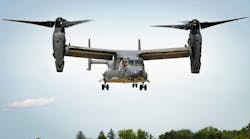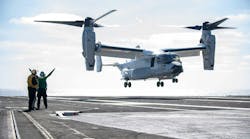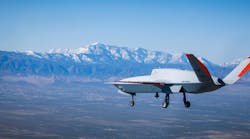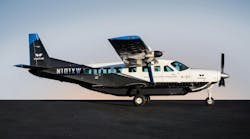March 04--There are fish stories and then there is this.
On the morning of Sept. 10, MacDill Air Force Base wildlife manager Lindsey Garven was called out to search the runway for a dead bird.
A short while earlier, a Gulfstream G-IV jet from National Oceanic and Atmospheric Administration rumbled down the runway until the crew noticed it hit something.
At first they thought the jet hit an osprey and aborted the flight.
Garven could not find any dead birds.
But she did find something else.
"I found a fish on the runway," says Garven. "It was a comical thing."
Garven picked up the fish, a nine-inch sheepshead, and met the NOAA crew at Hangar 5, where she collected DNA samples from the jet. She sent that off to the Smithsonian Institution's identification laboratory and two weeks later, received a report back.
The DNA on the plane belonged to the sheepshead.
"This was the first fish strike we have had on base," says Garven.
But not the first in history. In 1987, the New York Times reported that "a midair collision between a jet airliner and a fish delayed an Alaska Airlines flight for about an hour Monday while the plane was inspected for damage."
Still, such incidents are rare.
Federal Aviation Administration spokeswoman Kathleen Bergen referred questions about fish strikes to the FAA'ss Wildlife Strike Database. The database lists hundreds of species, from Acadian flycatchers to Zenaida doves. The list includes categories for yellow-bellied sapsuckers, red-footed boobys, Baltimore orioles and even burros, moose and horse.
But nothing for fish.
NOAA Lt. Cmdr. Nicholas Toth was incredulous over the incident MacDill personnel would jokingly come to refer to as "fishnado."
"At first, we didn't believe the test results," Toth told 6th Air Mobility Wing public affairs staff in a base publication. "There was no way we hit a fish during takeoff. I mean, how does something like that even happen?"
Garven says that a bird, most likely a juvenile bald eagle, was apparently eating the fish at the edge of the runway, took off and dropped it on the jet, escaping with its life, but not its lunch.
The sheepshead is prized by anglers for its fight and its taste. Garven says that while it sounds funny when one hits a plane, keeping animals off the runway is serious business.
Since 1987, U.S. military aircraft have suffered more than a half-billion dollars damage from 10 species of birds measured, according to a master's thesis written by U.S. Air Force Maj. Jason Trudel.
Wildlife has taken a toll on civilian aircraft as well, according to the Federal Aviation Administration, with nearly 120,000 collisions at more than 1,600 U.S. and more than 500 foreign civilian airports between January 1990, and December 2011, according to the FAA.
All told, the incidents have claimed about 300 lives, according to figures compiled by U.S. and Canadian military officials and a civilian pilots organization. One of the most famous aircraft crashes from a bird strike took place Jan. 16, 2009, when U.S. Airways Flight 1549 landed safely in the Hudson River after hitting a flock of geese. It made a hero of pilot Chesley "Sully" Sullenberger.
Two years ago, a Canadian air force jet landing at MacDill hit a vulture,. The jet landed safely, but was badly damaged.
The sheepshead caused no damage to the NOAA jet, says Garven, but "it left a streak of fish guts."
As an airport that has a lot of grass and juts out into a bay, MacDill is frequented by thousands of birds, says Garven. At peak times, MacDill officials say they see "meat tornadoes" of birds hovering over the base, which will stop air traffic until the birds depart,
Last year, there were 64 cases of Air Force aircraft hitting birds at MacDill, says Garven.
To help prevent that, she says she spends a lot of time patrolling the runway with her 6-year-old border collie Sonic "harassing" the wading birds, shore birds, raptors and song birds that frequent MacDill.
Birds aren't the only animal concern at MacDill, says Garven, a contractor for Birdstrike Control Program, a civilian company hire by MacDill to manage wildlife on the base.
"We have coyotes and supposedly pigs, but I haven't seen any pigs," says Garven.
The coyotes, she says, were removed years ago, but have been making a comeback.
"We have about five now," says Garven.
While there has yet to be a coyote strike, Garven says "pilots coming in for a landing observe them running across the field."
And that's a cause for concern, says Garven.
"If they cut right in front of the path, there could be some serious damage," she says.
As for the sheepshead, Garven says she and Sonic will do what they can to prevent a repeat of "fishnado."
"We can't prevent fish strikes," she says. "But we can keep birds from eating fish on the runway."
___
(813) 259-7629
@haltman
Copyright 2014 - Tampa Tribune, Fla.




